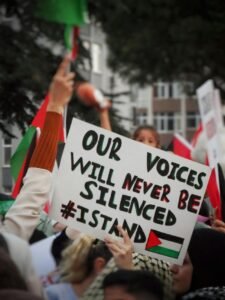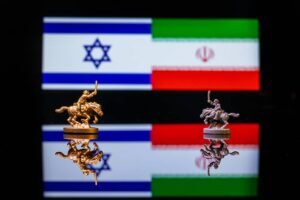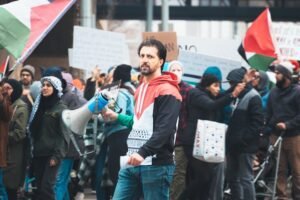A state of ambiguity and uncertainty hovers over the Middle Eastern region after Israel’s war on the Gaza Strip; due to the struggle of the neighbouring Arab regional countries, Iran and Turkey over status and influence within the region, through many tools. Most importantly sub-state actors employ them for their national interests. Some use the Palestinian cause to mask up their role in the Arab region.
One of the most prominent features of the prevailing ambiguity is the core of Israeli existence and its future in the region in terms of integration or conflict, and the efforts of the right and the far-right to deny the Palestinian cause altogether, and its feverish and irrational desires to liquidate it, through a war of extermination, forced displacement, settlement tendencies in the occupied West Bank, and the return of military control over Gaza Strip in the wake of the brutal war on defenceless civilians.
This political ambiguity emerged since the beginning of Operation Iron Swords, as the Israeli government and the Israeli war council within did not have a realistic vision of the goals of the war, nor its consequences after a comprehensive ceasefire, other than the dismantlement of the Hamas and Islamic Jihad movements, and finding a buffer zone on the territories of the Gaza Strip. This comes for security purposes, without a comprehensive vision for its future in light of an Israeli decisive rejection of the two-state solution. Despite some disagreements between the American government, President Biden and his democratic administration, or between Netanyahu and American policy, military and diplomatic support is guaranteed for Israel.
Recently, Netanyahu declared his vision for the post-war period, bringing more ambiguity and political extremism, regarding considerations related to his desire for the survival of his government coalition, its far-right components and its representatives, in addition to his attempt to prevent holding him accountable after the war.
Netanyahu’s vision was characterized by a sweeping majority in the council. It includes:
- Maintaining security control in the West Bank and Gaza Strip.
- Dismantling the Hamas and Islamic Jihad movements and releasing all hostages still being held in the Gaza Strip.
- Israeli forces should assume security supervision over “the entire area west of Jordan” by land, sea and air, in order to prevent the strengthening of what he considers terrorist elements in the West Bank and Gaza Strip and to thwart the threats issued by them against Israel.
- The Israeli army maintains an unlimited freedom of action throughout the Strip in order to prevent the return of armed activity.
- Israel will not allow the reconstruction of Gaza before completing the disarmament of the Palestinian factions.
- Implementing an education plan against extremism, by developing a new curricular, educational and religious policy.
The government began working on developing a model for local government in Gaza that would take charge of civil affairs as an alternative to Hamas.
According to Israeli media sources, the army began the process of “cleaning” up the Zaytoun Neighborhood in Gaza City to impose a model that gives the residents of the Strip the management of this neighbourhood, away from the Hamas movement. Add to that forming a system of the population to be responsible for receiving humanitarian aid and distributing it, to create an alternative rule to Hamas’es in northern Gaza, according to the Israeli Channel 12. In this context, the channel claimed that some Israeli officials met with representatives of the citizens of the Gaza Strip to move the project forward.
This project, according to Israeli descriptions, aims to create “humanitarian enclaves” in the areas from which Hamas was expelled. Benny Gantz described this project as an international project, not just an Israeli one, and that their mission is 100% security control and 0% civilian control. They are examining several paths to ensure that aid is transferred to Gaza through international management with the support of the United States. Israel is determined to Prevent the Palestinian Authority, which has limited powers in the occupied West Bank, from exercising any role in being a partner in the “humanitarian enclaves” because it did not “condemn” the Al-Aqsa flood attack!
This Israeli far-right project seeks to change the geography and demographics of the Palestinian territories, according to one of Hamas’s leaders – Osama Hamdan – and involves refusing to recognize a Palestinian state, in addition to the ambiguous American two-state solution, separating Gaza and the West Bank, as well as Jerusalem from the West Bank, and fragmenting and seizing the Palestinian lands. Some of this project is likely to be implemented. However, most of it involves ambiguity and the inability to be verified in actual reality. Because it represents a re-presentation of the (Village Links) project that failed in the city of Hebron nearly 40 years ago and was presented beyond the principles of autonomy in the Two-Frameworks Agreement with the Camp David Accords, which we previously criticized historically and in a comparative way at the time in Al-Ahram Centre for Political and Strategic studies.
The project deals with Hamas as a military organization, and not as a Palestinian faction with ideology, or a social movement that has its bases in the structure of the social system in the Gaza Strip and the West Bank. It also neglected the formation of the majority of young people and children over many decades. Meanwhile, at the same time represents the idea and culture of resistance. The project brings back the ideas that were associated with the concept of “normalization” that took place in Germany and Japan after World War II, forgetting that it is a racist colonial-settler occupation authority and that the leaders of the “humanitarian enclaves” are elderly people, who will not be acknowledged by young people, except as an agent group of the Israeli colonialist, its intelligence and its services.
These general, liquid and ambiguous principles are rejected by the Netanyahu government, yet they are not specific about the recognition of an independent Palestinian state. Biden talks about “patterns of states,” that is, demilitarized, and declared that the US cannot find a vision for the issue of the right of return, the issue of refugees, nor the status of East Jerusalem. What increases the ambiguity of this American perception is what National Security Advisor Jake Sullivan presented at the Davos conference in January 2024, a vision that includes three elements, according to some experts:
1– Normalization 2- Israel’s security 3- The Palestinian state.
In the same context, what was leaked in the media revealed some agreement among some of the concerned Arab countries on a comprehensive ceasefire, recognition of a Palestinian state, participation in the reconstruction of Gaza, and normalization of relations with Israel. It is possible to arrange and restore their priorities in this context, such that they include reconstruction, normalization, and then recognition of the independent Palestinian state.
The ambiguity and lack of specification of the post-war situation indicate the dominance of the Israeli vision and its rejection of the two-state solution, which has come to represent an “accursed devil” in the perception of the right and the religious far-right, and its mythical visions that deny the existence of the Palestinian people, the Palestinian territories, and their legitimate right to self-determination. His destiny, and build his independent state on the lands occupied after June 5, 1967, with East Jerusalem as its capital.
Published in Arabic by Al-Ahram
February 2024









